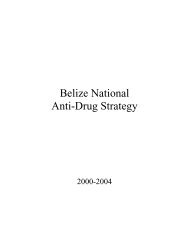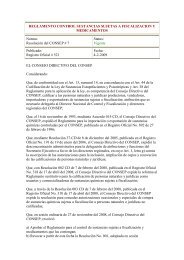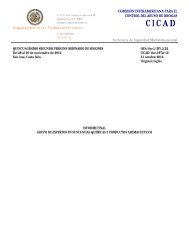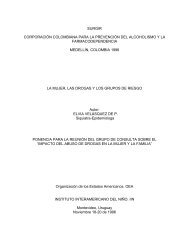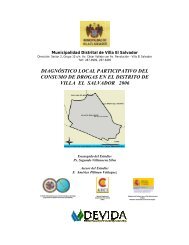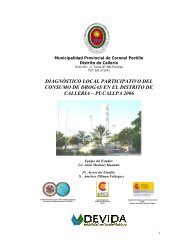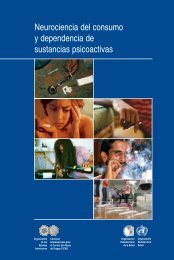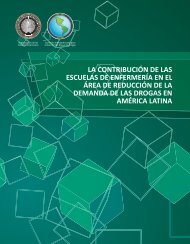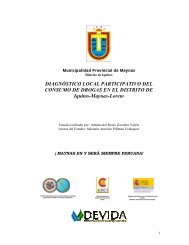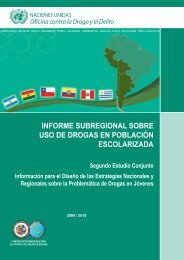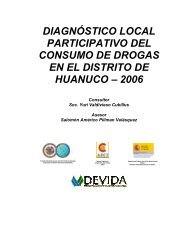The EFQM Excellence Model In Action - cicad
The EFQM Excellence Model In Action - cicad
The EFQM Excellence Model In Action - cicad
Create successful ePaper yourself
Turn your PDF publications into a flip-book with our unique Google optimized e-Paper software.
<strong>The</strong> <strong>EFQM</strong> <strong>Excellence</strong> <strong>Model</strong> <strong>In</strong> <strong>Action</strong><br />
Advice Booklet 00: Starting Out<br />
Publications
Starting Out on the<br />
journey to <strong>Excellence</strong><br />
Section 1<br />
<strong>EFQM</strong> values diversity and seeks to produce material that is free of stereotypes, cultural caricatures<br />
and gender bias. However, there may be occasions where the male personal pronoun is used to<br />
represent men and women.<br />
© 2000 <strong>EFQM</strong><br />
It is the <strong>EFQM</strong>’s intent to encourage the widespread use of this material within companies and organisations.<br />
However, no part of this publication may be reproduced, stored in a retrieval system, or communicated in any form<br />
or by any means (be this electronically, mechanically, through photocopy or recording, or otherwise) without the prior<br />
written permission from the copyright owner."
Starting Out<br />
1<br />
<strong>In</strong>troduction<br />
<strong>The</strong> <strong>EFQM</strong> Advice Booklets<br />
Audience and Purpose<br />
1 <strong>The</strong> journey to <strong>Excellence</strong><br />
1.1 Mapping out the route<br />
1.2 Using the <strong>EFQM</strong> Levels of <strong>Excellence</strong><br />
2 What is <strong>Excellence</strong> & Why is it important<br />
2.1 A brief history of <strong>Excellence</strong> in Europe<br />
2.2 <strong>The</strong> <strong>EFQM</strong> Fundamental Concepts of <strong>Excellence</strong><br />
2.3 <strong>The</strong> <strong>EFQM</strong> <strong>Excellence</strong> <strong>Model</strong><br />
2.4 PDCA and the logic of RADAR<br />
3 Where are you on the journey to <strong>Excellence</strong><br />
3.1 Self-Assessment<br />
3.2 Benchmarking<br />
4 How do you put <strong>Excellence</strong> into practice<br />
4.1 <strong>The</strong> Role and Ownership of change<br />
4.2 Setting Objectives for Change<br />
4.3 <strong>In</strong>volving your People in Change<br />
4.4 Project Management<br />
5 Reprise<br />
6 Acknowledgements<br />
6.1 Organisations featured in all Booklets<br />
6.2 Authors and contributors<br />
7 Appendices<br />
Appendix 1<br />
Appendix 2<br />
Appendix 3<br />
Appendix 4<br />
Appendix 5<br />
<strong>The</strong> <strong>EFQM</strong> Fundamental Concepts of <strong>Excellence</strong><br />
<strong>The</strong> <strong>EFQM</strong> <strong>Excellence</strong> <strong>Model</strong><br />
Pathfinder Card® and RADAR Scoring Matrix®<br />
<strong>The</strong> five main approaches to Self-Assessment<br />
More information on Benchmarking<br />
8 Further Sources of Knowledge -<br />
A list of useful reading, websites and training courses<br />
V2.0/En
2<br />
Welcome to the <strong>EFQM</strong> Starting Out Booklet -<br />
number 0 in the series of 10 Advice Booklets.<br />
<strong>The</strong> <strong>EFQM</strong> Advice Booklets<br />
<strong>The</strong>se Booklets have been primarily designed to support organisations with an interest in the Committed to <strong>Excellence</strong><br />
strand of <strong>EFQM</strong>’s three-tiered <strong>EFQM</strong> Levels of <strong>Excellence</strong> European Recognition Scheme. However, they will also appeal<br />
to anyone interested in introducing the concepts, or improving the practices, of Performance <strong>Excellence</strong> in their organisation.<br />
Booklet 0 is the introductory Booklet. It gives general advice on the implementation of <strong>Excellence</strong> into an organisation using<br />
the <strong>EFQM</strong> <strong>Excellence</strong> <strong>Model</strong>. It will outline what you can expect to read in the other 9 Booklets, as well as establishing the<br />
links and complementary relationships between the Booklets. It will also<br />
introduce you to the <strong>EFQM</strong> Levels of <strong>Excellence</strong> European Recognition<br />
Scheme, specifically the Committed to <strong>Excellence</strong> strand, and explain how<br />
your organisation can become involved.<br />
® <strong>The</strong> <strong>EFQM</strong> <strong>Excellence</strong> <strong>Model</strong> is a registered Trademark<br />
Booklets 1 - 9 are based on the 9 Criteria of the <strong>EFQM</strong> <strong>Excellence</strong> <strong>Model</strong><br />
and provide advice and ideas for developing Good Practice approaches<br />
across all 9 Criteria. <strong>The</strong> structure and style of the Booklets is similar, each<br />
exploring the key concepts of one Criterion. Examples and quotes from<br />
organisations with a proven track record are included throughout, either<br />
highlighting the relevance of a concept to them or describing how they have<br />
put a concept into practice. At various points, you will be asked questions<br />
which help you to consider your own organisation and how to implement<br />
Good Practice.<br />
You are currently reading Booklet number 0 - STARTING OUT.<br />
Booklet 0 Starting Out<br />
Booklet 1 Leadership<br />
Booklet 2 Policy and Strategy<br />
Booklet 3 People<br />
Booklet 4 Partnerships and Resources<br />
Booklet 5 Processes<br />
Booklet 6 Customer Results<br />
Booklet 7 People Results<br />
Booklet 8 Society Results<br />
Booklet 9 Key Performance Results<br />
Audience and Purpose<br />
<strong>The</strong> <strong>EFQM</strong> Advice Series of Booklets is relevant to all types of organisations: commercial or public, for profit, not-for-profit,<br />
voluntary, charities, large or small, because all organisations need to strive for sustainable <strong>Excellence</strong>.<br />
We have designed these Booklets as a practical knowledge tool to support you in considering how to achieve Performance<br />
<strong>Excellence</strong>. <strong>The</strong>re may be professionals within your organisation who specialise in Financial Management, Project<br />
Management, TQM, Quality Control, Human Resource Management, TPM, or any of the other quality and management<br />
disciplines and their expertise may help you to understand and implement some of the suggestions in these Booklets.<br />
However, these Booklets are aimed at everyone who is involved with the leadership and management of an organisation and<br />
wishes to improve.<br />
Organisations begin on the journey to <strong>Excellence</strong> from many different start points. You may already be familiar with good<br />
business practice and now wish to use the concepts of <strong>Excellence</strong> to bring everything together. Perhaps you have been<br />
involved in obtaining ISO 9000 certification or other quality initiatives and now wish to take a wider look at your management<br />
practices. Or maybe you just want to improve your organisation and want to find out if there is anything that could help you.<br />
Whatever your start point, the <strong>EFQM</strong> Advice Series of Booklets are designed to help you understand the basis of <strong>Excellence</strong>.<br />
<strong>The</strong> purpose of this Booklet is to stimulate your creativity, helping you to produce ideas for turning other organisations’ Good<br />
Practice into your own unique way of starting out on the journey to <strong>Excellence</strong>!<br />
<strong>In</strong> this Booklet, we will consider the main reasons why <strong>Excellence</strong> and the use of the <strong>EFQM</strong> <strong>Excellence</strong> <strong>Model</strong> are<br />
important to your organisation. We also want to demonstrate the linkages between the how you manage what you do (the<br />
Enablers) and what is being achieved in relation to your Results.<br />
We will look at several of the many Good Practices for obtaining realistic and useful measures. We will<br />
then consider how you prioritise, plan and implement improvements and some of the proven techniques for doing this.<br />
Throughout we will give real-life examples of how other organisations have approached the issues raised.<br />
Throughout this Booklet, you are invited to consider the implications for yourself and your organisation. Practice, not theory is<br />
the basis for all the Booklets in the <strong>EFQM</strong> Advice Series.
<strong>The</strong> <strong>EFQM</strong> <strong>Excellence</strong> <strong>Model</strong> <strong>In</strong> <strong>Action</strong><br />
Advice Booklet 01: Leadership<br />
Publications
“Leadership is about getting extraordinary<br />
results from ordinary people”<br />
Sir John Harvey Jones<br />
Section 1<br />
<strong>EFQM</strong> values diversity and seeks to produce material that is free of stereotypes, cultural caricatures<br />
and gender bias. However, there may be occasions where the male personal pronoun is used to<br />
represent men and women.<br />
© 2000 <strong>EFQM</strong><br />
It is the <strong>EFQM</strong>’s intent to encourage the widespread use of this material within companies and organisations. However, no<br />
part of this publication may be reproduced, stored in a retrieval system, or communicated in any form<br />
or by any means (be this electronically, mechanically, through photocopy or recording, or otherwise) without the prior written<br />
permission from the copyright owner."
Leadership<br />
1<br />
<strong>In</strong>troduction<br />
<strong>The</strong> <strong>EFQM</strong> Advice Booklets<br />
Audience and Purpose<br />
1 What is Leadership<br />
1.1 Overview<br />
1.2 Who are Leaders<br />
1.3 What do Leaders do<br />
2 How do you put Leadership into Practice<br />
2.1 Establish a Vision and Mission<br />
2.2 <strong>In</strong>stil Values and a Culture of <strong>Excellence</strong><br />
2.3 Communication, Communication, Communication<br />
2.4 Act as ‘agents of change’<br />
3 How do you review and improve your leadership<br />
3.1 Reviewing techniques<br />
3.2 How to Improve<br />
4 Reprise & linkages<br />
5 Acknowledgements<br />
5.1 Organisations featured in this Booklet<br />
6 Further Sources of Knowledge -<br />
A list of useful reading<br />
V2.0/En
2<br />
Welcome to the <strong>EFQM</strong> Leadership Booklet -<br />
number 1 in the series of 10 Advice Booklets.<br />
<strong>The</strong> <strong>EFQM</strong> Advice Booklets<br />
<strong>The</strong>se Booklets have been primarily designed to support organisations with an interest in the Recognition of Commitment<br />
to <strong>Excellence</strong> strand of <strong>EFQM</strong>’s three-tiered European Recognition Scheme. However, they will also appeal to anyone interested<br />
in introducing the concepts, or improving the practices, of Performance <strong>Excellence</strong> in their organisation.<br />
Booklet 0 is the introductory Booklet. It gives general advice on the implementation of <strong>Excellence</strong> into an organisation using<br />
the <strong>EFQM</strong> <strong>Excellence</strong> <strong>Model</strong>. It will outline what you can expect to read in the other 9 Booklets, as well as establishing the<br />
links and complementary relationships between the booklets. It will also introduce you to the European Recognition Scheme<br />
and specifically the Recognition of Commitment to <strong>Excellence</strong> strand and explain how your organisation can become involved.<br />
Booklets 1 - 9 are each based on one of the 9 Criteria of the <strong>EFQM</strong> <strong>Excellence</strong> <strong>Model</strong> and provide advice and ideas for developing<br />
Good Practice approaches across all 9 Criteria. You are currently reading Booklet number 1 - LEADERSHIP.<br />
Leadership is Criterion 1 in the <strong>EFQM</strong> <strong>Excellence</strong> <strong>Model</strong> and is<br />
defined as "How Leaders develop and facilitate the achievement<br />
of the vision and mission, develop values required for<br />
long term success and implement these via appropriate<br />
actions and behaviours, and are personally involved in<br />
ensuring that the organisation’s management systems are<br />
developed". We can see how LEADERSHIP fits into a framework<br />
of <strong>Excellence</strong> (left).<br />
® <strong>The</strong> <strong>EFQM</strong> <strong>Excellence</strong> <strong>Model</strong> is a registered Trademark<br />
For more information about the <strong>EFQM</strong> <strong>Excellence</strong> <strong>Model</strong> or<br />
Self-Assessment, please contact the Brussels Representative<br />
Office at info@efqm.org, or check out <strong>EFQM</strong>'s website on<br />
www.efqm.org.<br />
Audience and Purpose<br />
This Booklet is relevant to all types of organisations: commercial or public, for profit, not-for-profit, voluntary, charities, large<br />
or small because all organisations need Leaders.<br />
We have designed this Booklet as a practical knowledge tool to support you in considering how to achieve Performance<br />
<strong>Excellence</strong>. We want the Booklet to stimulate your creativity, helping you to produce ideas for turning other people’s Good<br />
Practice into your own unique way of developing and implementing Leadership.<br />
We will consider the main attributes and purpose of Leadership. We will then concentrate on a few of the many practices of<br />
good Leadership, giving real-life examples of how other organisations have approached the issues raised. We will then look<br />
at a few of the ways of assessing your Leadership. Leadership is one of the 5 Enablers of the <strong>EFQM</strong> <strong>Excellence</strong> <strong>Model</strong>. We<br />
also want to demonstrate the linkages between the how you manage what you do (the Enablers) and what is being achieved<br />
in relation to your Results.<br />
Throughout the Booklet, you are invited to consider the implications for yourself and your organisation. Practice, not theory,<br />
is the basis for this Booklet
<strong>The</strong> <strong>EFQM</strong> <strong>Excellence</strong> <strong>Model</strong> <strong>In</strong> <strong>Action</strong><br />
Advice Booklet 02: Policy & Strategy<br />
Publications
“Would you tell me, please,<br />
which way I ought to go from here”<br />
“That depends a good deal on where<br />
you want to get to,” said the Cat.<br />
“I don’t much care where,” said Alice.<br />
“<strong>The</strong>n it doesn’t matter which way you go,”said the<br />
Cat.<br />
Acknowledgements to Lewis Carroll - Alice’s Adventures in Wonderland<br />
Section 1<br />
<strong>EFQM</strong> values diversity and seeks to produce material that is free of stereotypes, cultural caricatures<br />
and gender bias. However, there may be occasions where the male personal pronoun is used to<br />
represent men and women.<br />
© 2000 <strong>EFQM</strong><br />
It is the <strong>EFQM</strong>’s intent to encourage the widespread use of this material within companies and organisations.<br />
However, no part of this publication may be reproduced, stored in a retrieval system, or communicated in any form<br />
or by any means (be this electronically, mechanically, through photocopy or recording, or otherwise) without the prior<br />
written permission from the copyright owner."
Policy<br />
& Strategy<br />
1<br />
<strong>In</strong>troduction<br />
<strong>The</strong> <strong>EFQM</strong> Advice Booklets<br />
Audience and Purpose<br />
1 How do you know who your Stakeholders are<br />
and their expectations of your organisation<br />
2 What information, from what sources, do you use<br />
to help inform your future direction<br />
3 How do you develop, review and update your plans<br />
for the future<br />
4 How do you deploy your plans for the future<br />
throughout the organisation<br />
5 How are your plans for the future communicated<br />
and implemented<br />
6 Reprise & Linkages<br />
7 Acknowledgements<br />
7.1 Organisations featured in this Booklet.<br />
8 Further Sources of Knowledge -<br />
A list of useful reading<br />
V2.0/En
2<br />
Welcome to the <strong>EFQM</strong> Policy & Strategy Booklet -<br />
number 2 in a series of 10 Advice Booklets.<br />
<strong>The</strong> <strong>EFQM</strong> Advice Booklets<br />
<strong>The</strong>se Booklets have been primarily designed to support organisations with an interest in the Recognition of Commitment<br />
to <strong>Excellence</strong> strand of <strong>EFQM</strong>’s three-tiered European Recognition Scheme. However, they will also appeal to anyone<br />
interested in introducing the concepts, or improving the practices of Performance <strong>Excellence</strong> in their organisation.<br />
Booklet 0 is the introductory Booklet. It provides general advice on the implementation of <strong>Excellence</strong>, based on the <strong>EFQM</strong><br />
<strong>Excellence</strong> <strong>Model</strong>. It outlines what you can expect to read in the other 9 Booklets, as well as establishing links and<br />
relationships between the Booklets. It will also introduce you to the European Recognition Scheme and how your organisation<br />
can become involved.<br />
Booklets 1 - 9 are each based on one of the 9 Criteria of the <strong>EFQM</strong> <strong>Excellence</strong> <strong>Model</strong> and they provide advice and ideas for<br />
developing good practice approaches across all 9 Criteria. You are currently reading Booklet 2 - POLICY & STRATEGY.<br />
Policy & Strategy is Criterion 2 in the <strong>EFQM</strong> <strong>Excellence</strong> <strong>Model</strong> and<br />
is defined as "How the organisation implements its mission<br />
and vision via a clear stakeholder focused strategy,<br />
supported by relevant policies, plans, objectives, targets and<br />
processes."<br />
We can see how POLICY & STRATEGY fits into a framework of<br />
<strong>Excellence</strong> (left).<br />
® <strong>The</strong> <strong>EFQM</strong> <strong>Excellence</strong> <strong>Model</strong> is a registered Trademark<br />
For more information about the <strong>EFQM</strong> <strong>Excellence</strong> <strong>Model</strong> or Self-<br />
Assessment, please contact <strong>EFQM</strong>’s Representative Office at<br />
info@efqm.org, or check out <strong>EFQM</strong>’s web site on<br />
www.efqm.org® <strong>The</strong> <strong>EFQM</strong> <strong>Excellence</strong> <strong>Model</strong> is a registered Tradema<br />
"<strong>The</strong> 4 P’s – Planning Prevents Poor Performance."<br />
Edinburgh <strong>In</strong>ternational Conference Centre<br />
Audience and Purpose<br />
This Booklet is relevant to all types of organisations: commercial or public, for profit, not for profit, voluntary and charities, large<br />
or small.<br />
We have designed this Booklet as a practical knowledge tool to support you in considering how to achieve performance<br />
excellence within this Criterion. We want the Booklet to stimulate your creativity, helping you to produce ideas for turning other<br />
people’s Good Practice into your own unique way of building, deploying and reviewing how you determine your future<br />
direction. We also want to demonstrate the linkages between the how you manage what you do (the Enablers) and what is<br />
being achieved in relation to your Results.<br />
All organisations have a purpose, a "raison d’être". <strong>The</strong>y exist to do something, be it the delivery of a product or a service.<br />
Many organisations summarise this reason for existing within what is often called a Mission statement. For instance, Yellow<br />
Pages, a UK based subsidiary of BT, with operations also in the USA, describes its business purpose as follows
<strong>The</strong> <strong>EFQM</strong> <strong>Excellence</strong> <strong>Model</strong> <strong>In</strong> <strong>Action</strong><br />
Advice Booklet 03: People<br />
Publications
“ <strong>The</strong> secret of our success is our major resource:<br />
PEOPLE PEOPLE PEOPLE ”<br />
ST Microelectronics<br />
Section 1<br />
<strong>EFQM</strong> values diversity and seeks to produce material that is free of stereotypes, cultural caricatures<br />
and gender bias. However, there may be occasions where the male personal pronoun is used to<br />
represent men and women.<br />
© 2000 <strong>EFQM</strong><br />
It is the <strong>EFQM</strong>’s intent to encourage the widespread use of this material within companies and organisations.<br />
However, no part of this publication may be reproduced, stored in a retrieval system, or communicated in any form<br />
or by any means (be this electronically, mechanically, through photocopy or recording, or otherwise) without the prior<br />
written permission from the copyright owner."
People<br />
1<br />
INTRODUCTION<br />
<strong>The</strong> <strong>EFQM</strong> Advice Booklets<br />
Audience and Purpose<br />
1 Why People<br />
1.1 Overview<br />
1.2 Who are your people<br />
1.3 What do people mean to your organisation<br />
2 How do you manage, develop and involve the People<br />
in your organisation<br />
2.1 Plan, manage and improve your people resources<br />
2.2 Develop your people’s knowledge and competencies<br />
2.3 <strong>In</strong>volve and Empower your people<br />
2.4 Communicate with your people<br />
2.5 Reward, recognise and care for your people<br />
3 How do you review and improve your people management<br />
3.1 Reviewing techniques<br />
3.2 How to Improve<br />
4 Reprise & linkages<br />
5 Acknowledgements<br />
5.1 Organisations featured in this Booklet<br />
6 Further Sources of Knowledge:<br />
A list of useful reading and websites<br />
V2.0/En
2<br />
Welcome to the <strong>EFQM</strong> People Booklet -<br />
number 3 in a series of 10 Advice Booklets.<br />
<strong>The</strong> <strong>EFQM</strong> Advice Booklets<br />
<strong>The</strong>se Booklets have been primarily designed to support organisations with an interest in the Recognition of Commitment<br />
to <strong>Excellence</strong> strand of <strong>EFQM</strong>’s three-tiered European Recognition Scheme. However, they will also appeal to anyone<br />
interested in introducing the concepts, or improving the practices, of Performance <strong>Excellence</strong> in their organisation.<br />
Booklet 0 is the introductory Booklet. It gives general advice on the implementation of <strong>Excellence</strong> into an organisation using<br />
the <strong>EFQM</strong> <strong>Excellence</strong> <strong>Model</strong>. It will outline what you can expect to read in the other 9 Booklets, as well as establishing the<br />
links and complementary relationships between the Booklets. It will also introduce you to the European Recognition Scheme<br />
and specifically the Recognition of Commitment to <strong>Excellence</strong> strand, and explain how your organisation can become<br />
involved.<br />
Booklets 1-9 are each based on one of the 9 Criteria of the <strong>EFQM</strong><br />
<strong>Excellence</strong> <strong>Model</strong> and provide advice and ideas for developing<br />
Good Practice approaches across all 9 Criteria. You are currently<br />
reading Booklet number 3 – PEOPLE<br />
People is Criterion 3 in the <strong>EFQM</strong> <strong>Excellence</strong> <strong>Model</strong> and is defined<br />
as "How the organisation manages, develops and releases<br />
the knowledge and full potential of its people at an individual,<br />
team-based and organisation-wide level, and plans these<br />
activities in order to support its policy and strategy and the<br />
effective operation of its processes".<br />
We can see how PEOPLE fits into a framework of <strong>Excellence</strong> (left).<br />
® <strong>The</strong> <strong>EFQM</strong> <strong>Excellence</strong> <strong>Model</strong> is a registered Trademark<br />
For more information about the <strong>EFQM</strong> <strong>Excellence</strong> <strong>Model</strong> or Self-<br />
Assessment, please contact <strong>EFQM</strong>’s Representative Office at<br />
info@efqm.org, or check out <strong>EFQM</strong>’s web site on www.efqm.org<br />
Audience and Purpose<br />
This Booklet is relevant to all types of organisations: commercial or public, for profit, not-for-profit, voluntary, charities, large<br />
or small because all organisations need People.<br />
We have designed this Booklet as a practical knowledge tool to support you in considering how to achieve Performance<br />
<strong>Excellence</strong>. <strong>The</strong> Booklet is not intended to be a manual covering the many aspects of Human Resource Management. <strong>The</strong>re<br />
are many publications that can help you with the legal, administrative and practical aspects of employing and managing<br />
people. <strong>The</strong> purpose of this Booklet is to stimulate your creativity, helping you to produce ideas for turning other organisations’<br />
Good Practice into your own unique way of developing, empowering and recognising your People.<br />
We will consider the main reasons why People are important to your organisation. We will then concentrate on some of the<br />
many Good Practices for getting the best from your people, giving real-life examples of how other organisations have<br />
approached the issues raised. We will then look at a few of the ways of assessing how well you manage your people. People<br />
is one of the 5 Enablers of the <strong>EFQM</strong> <strong>Excellence</strong> <strong>Model</strong>. We also want to demonstrate the linkages between the how you<br />
manage what you do (the Enablers) and what is being achieved in relation to your Results.<br />
Throughout the Booklet, you are invited to consider the implications for yourself and your organisation. Practice, not theory is<br />
the basis for this Booklet.
<strong>The</strong> <strong>EFQM</strong> <strong>Excellence</strong> <strong>Model</strong> <strong>In</strong> <strong>Action</strong><br />
Advice Booklet 04: Partnerships & Resources<br />
Publications
Section 1<br />
<strong>EFQM</strong> values diversity and seeks to produce material that is free of stereotypes, cultural caricatures<br />
and gender bias. However, there may be occasions where the male personal pronoun is used to<br />
represent men and women.<br />
© 2000 <strong>EFQM</strong><br />
It is the <strong>EFQM</strong>’s intent to encourage the widespread use of this material within companies and organisations.<br />
However, no part of this publication may be reproduced, stored in a retrieval system, or communicated in any form<br />
or by any means (be this electronically, mechanically, through photocopy or recording, or otherwise) without the prior<br />
written permission from the copyright owner."
Partnerships<br />
& Resources<br />
1<br />
<strong>In</strong>troduction<br />
<strong>The</strong> <strong>EFQM</strong> Advice Booklets<br />
Audience and Purpose<br />
Why Partnerships & Resources<br />
1 Partnerships<br />
1.1 What do we mean by Partnerships<br />
1.2 How do I decide who could be a good Partner for me<br />
1.3 What about my current suppliers, where do they fit<br />
1.4 What are the benefits of adopting a Partnership approach<br />
2 Resources<br />
2.1 What do we mean by Resources<br />
3 Financial Management<br />
3.1 How do you manage your finances to support your plans<br />
in the future<br />
4 Buildings, Equipment & Material<br />
4.1 How do you manage your buildings, equipment and material<br />
in support of your plans<br />
5 <strong>The</strong> Management of Technology<br />
5.1 How do you manage technology to help improve your current<br />
performance and your plans for the future<br />
6 <strong>The</strong> Management of <strong>In</strong>formation & Knowledge<br />
6.1 What do we mean by <strong>In</strong>formation & Knowledge<br />
7 Reprise & Linkages<br />
Reprise<br />
Linkages<br />
8 Acknowledgements<br />
8.1 Organisations featured in this Booklet<br />
9 Further Sources of Knowledge -<br />
A list of useful reading and websites<br />
V2.0/En
2<br />
Welcome to the <strong>EFQM</strong> Policy & Strategy Booklet -<br />
number 4 in a series of 10 Advice Booklets.<br />
<strong>The</strong> <strong>EFQM</strong> Advice Booklets<br />
<strong>The</strong>se Booklets have been primarily designed to support organisations with an interest in the Recognition of Commitment to<br />
<strong>Excellence</strong> strand of <strong>EFQM</strong>’s three-tiered European Recognition Scheme. However, they will also appeal to anyone<br />
interested in introducing the concepts, or improving the practices, of Performance <strong>Excellence</strong> in their organisation.<br />
Booklet 0 is the introductory Booklet. It provides general advice on the implementation of <strong>Excellence</strong>, based on the <strong>EFQM</strong><br />
<strong>Excellence</strong> <strong>Model</strong>. It outlines what you can expect to read in the other 9 Booklets, as well as establishing links and<br />
relationships between the Booklets. It will also introduce you to the European Recognition Scheme and how your organisation<br />
can become involved.<br />
Booklets 1 - 9 are each based on one of the 9 Criteria of the<br />
<strong>EFQM</strong> <strong>Excellence</strong> <strong>Model</strong> and they provide advice and ideas<br />
for developing Good Practice approaches across all 9 Criteria.<br />
You are currently reading Booklet 4 - PARTNERSHIPS &<br />
RESOURCES.<br />
Partnerships and Resources is Criterion 4 in the <strong>EFQM</strong><br />
<strong>Excellence</strong> <strong>Model</strong> and is defined as “How the organisation<br />
plans and manages its external partnerships and internal<br />
resources in order to support its policy & strategy and the<br />
effective operation of its processes.”<br />
We can see how PARTNERSHIPS & RESOURCES fits into a<br />
framework of <strong>Excellence</strong> (left).<br />
<strong>The</strong> <strong>EFQM</strong> <strong>Excellence</strong> <strong>Model</strong> is a registered Trademark<br />
For more information about the <strong>EFQM</strong> <strong>Excellence</strong> <strong>Model</strong> or<br />
Self-Assessment, please contact <strong>EFQM</strong>’s Representative<br />
Office, info@efqm.org or check out <strong>EFQM</strong>’s web site on<br />
www.efqm.org.<br />
Audience and Purpose<br />
This Booklet is relevant to all types of organisations: commercial or public, for profit, not for profit, voluntary and charities, large<br />
or small.<br />
We have designed this Booklet as a practical knowledge tool to support you in considering how to achieve Performance<br />
<strong>Excellence</strong> within the area of Partnerships & Resources. We want this Booklet to stimulate your creativity, helping you to<br />
produce ideas for turning other people’s Good Practice into your own unique way of making best use of both partnership<br />
opportunities and the resources at your disposal.<br />
We also want to demonstrate the linkages between how you manage what you do (the Enablers) and what is being achieved<br />
in relation to your Results.<br />
Why Partnerships & Resources<br />
Any organisation has a finite number of resources at its disposal. <strong>The</strong> challenge is how to make best use of these finite<br />
resources.<br />
One such resource is its workforce and the issues of how best to manage that specific area, (its human capital), is dealt with<br />
in Booklet 3.<br />
<strong>The</strong> other resources at an organisation’s disposal can be segmented into two categories.<br />
<strong>The</strong>re are those resources that are “within its four walls” <strong>The</strong> organisation has direct control over these inanimate resources<br />
and typical examples would be the buildings, the machinery, the documented systems and procedures, the materials,<br />
technology, patents, etc.<br />
<strong>The</strong> second grouping defines those resources an organisation has access to “outside its four walls”. This second grouping<br />
consists of other organisations that it could do business with, organisations that can help it, for instance, to deliver customer<br />
satisfaction or share investment in expensive research. <strong>The</strong>se organisations could be some of your suppliers. Perhaps if you<br />
are a public sector entity, it could be a commercial business, university, and even, in certain circumstances, your competitors.
<strong>The</strong> <strong>EFQM</strong> <strong>Excellence</strong> <strong>Model</strong> <strong>In</strong> <strong>Action</strong><br />
Advice Booklet 05: Processes<br />
Publications
Section 1<br />
<strong>EFQM</strong> values diversity and seeks to produce material that is free of stereotypes, cultural caricatures<br />
and gender bias. However, there may be occasions where the male personal pronoun is used to<br />
represent men and women.<br />
© 2000 <strong>EFQM</strong><br />
It is the <strong>EFQM</strong>’s intent to encourage the widespread use of this material within companies and organisations.<br />
However, no part of this publication may be reproduced, stored in a retrieval system, or communicated in any form or<br />
by any means (be this electronically, mechanically, through photocopy or recording, or otherwise) without the prior<br />
written permission from the copyright owner."
Processes<br />
1<br />
<strong>In</strong>troduction<br />
<strong>The</strong> <strong>EFQM</strong> Advice Booklets<br />
Audience and Purpose<br />
1 What do we mean by Processes<br />
2 How do I identify my Key Processes<br />
3 Building a Process <strong>Model</strong> of the Organisation<br />
4 <strong>The</strong> Process <strong>Model</strong> and Process Mapping Tools<br />
5 <strong>The</strong> Role of Measurement in Process thinking<br />
6 How do you Manage and Review your Processes<br />
7 Key Learning Points & the Seven Deadly Sins<br />
8 Reprise & Linkages<br />
8.1 Reprise<br />
8.2 Linkages<br />
9 Acknowledgements<br />
9.1 Organisations featured in this Booklet<br />
10 Further Sources of Knowledge -<br />
A list of useful reading and websites<br />
V2.0/En
2<br />
Welcome to the <strong>EFQM</strong> Processes Booklet -<br />
Number 5 in a series of 10 Advice Booklets<br />
<strong>The</strong> <strong>EFQM</strong> Advice Booklets<br />
<strong>The</strong>se Booklets have been primarily designed to support organisations with an interest in the Recognition of Commitment<br />
to <strong>Excellence</strong> strand of <strong>EFQM</strong>’s three-tiered European Recognition Scheme. However, they will also appeal to anyone<br />
interested in introducing the concepts, or improving the practices, of Performance <strong>Excellence</strong> in their organisation.<br />
Booklet 0 is the introductory Booklet. It provides general advice on the implementation of <strong>Excellence</strong>, based on the <strong>EFQM</strong><br />
<strong>Excellence</strong> <strong>Model</strong>. It outlines what you can expect to read in the other 9 Booklets, as well as establishing links and<br />
relationships between the Booklets. It will also introduce you to the European Recognition Scheme and specifically the<br />
Recognition of Commitment to <strong>Excellence</strong> strand and explain how your organisation can become involved.<br />
Booklets 1 - 9 are each based on one of the 9 Criteria of the<br />
<strong>EFQM</strong> <strong>Excellence</strong> <strong>Model</strong> and they provide advice and ideas<br />
for developing Good Practice approaches across all 9 Criteria.<br />
You are currently reading Booklet 5 - PROCESSES.<br />
Processes is Criterion 5 in the <strong>EFQM</strong> <strong>Excellence</strong> <strong>Model</strong> which<br />
is defined as “How the organ-isation designs, manages<br />
and improves its processes in order to support its policy<br />
& strategy and fully satisfy, and generate increasing<br />
value for, its customers and other stakeholders.” We can<br />
see how PROCESSES fits into a framework of <strong>Excellence</strong><br />
(left).<br />
® <strong>The</strong> <strong>EFQM</strong> <strong>Excellence</strong> <strong>Model</strong> is a registered Trademark<br />
For more information about the <strong>EFQM</strong> <strong>Excellence</strong> <strong>Model</strong> or<br />
Self-Assessment, please contact <strong>EFQM</strong>’s Representative<br />
Office, or check out <strong>EFQM</strong>’s web site on www.efqm.org.<br />
Audience and Purpose<br />
This Booklet is relevant to all types of organisations: commercial or public, for profit, not for profit, voluntary and charities, large<br />
or small, because all organisations use processes, knowingly or otherwise, to deliver their products and services.<br />
This Booklet offers guidance to people in organisations thinking about starting on the journey towards a Process view of the<br />
world and includes examples from others recognised for their levels of <strong>Excellence</strong> in this area.<br />
Organisations that have changed to a Process perspective agree it is a journey without end. Making the shift from traditional,<br />
vertical management to a horizontal approach requires considerable commitment and planning to be successful, and we have<br />
designed this Booklet as a practical knowledge tool to support you in considering how to achieve Performance <strong>Excellence</strong><br />
within the area of Processes.<br />
We want this Booklet to stimulate your creativity, helping you to produce ideas for turning other people’s Good Practice into<br />
your own unique way of managing your organisation from a Process rather than functional perspective, recognising<br />
its value in helping you to deliver outstanding performance in all Stakeholder areas.<br />
Processes is one of the five Enablers of the <strong>EFQM</strong> <strong>Excellence</strong> <strong>Model</strong> and we also want to demonstrate the linkages between<br />
how you manage what you do (the Enablers) and what is being achieved in relation to your Results.<br />
Throughout the Booklet you are invited to consider the implications for yourself and your organisation. Practice, not theory, is<br />
the basis for this Booklet.
<strong>The</strong> <strong>EFQM</strong> <strong>Excellence</strong> <strong>Model</strong> <strong>In</strong> <strong>Action</strong><br />
Advice Booklet 06: Customer Results<br />
Publications
“ If you don’t measure you can’t<br />
improve and if you don’t measure in<br />
the correct way you don’t know<br />
exactly where you are ”<br />
Esther Toledo del Castillo. Director, Alstom Transporte Spain.<br />
<strong>EFQM</strong> European Quality Awards Finalist 1999<br />
Section 1<br />
<strong>EFQM</strong> values diversity and seeks to produce material that is free of stereotypes, cultural caricatures<br />
and gender bias. However, there may be occasions where the male personal pronoun is used to<br />
represent men and women.<br />
© 2000 <strong>EFQM</strong><br />
It is the <strong>EFQM</strong>’s intent to encourage the widespread use of this material within companies and organisations.<br />
However, no part of this publication may be reproduced, stored in a retrieval system, or communicated in any form<br />
or by any means (be this electronically, mechanically, through photocopy or recording, or otherwise) without the prior<br />
written permission from the copyright owner."
Customer<br />
Results<br />
1<br />
INTRODUCTION<br />
<strong>The</strong> <strong>EFQM</strong> Advice Booklets<br />
Audience and Purpose<br />
1 Why are Customer Results Important<br />
1.1 Overview<br />
1.2 Definition of a Customer<br />
1.3 Definition of a Customer Result – "Hows" lead to "Whats"<br />
1.4 Lagging and Leading <strong>In</strong>dicators explained<br />
1.5 Beyond Customer Satisfaction<br />
2 What are you Measuring and Reporting<br />
2.1 Perception Measures<br />
2.2 Performance indicators<br />
2.3 Range of Results (Scope and Segmentation)<br />
2.4 Setting Targets<br />
2.5 Trends<br />
2.6 Benchmark Data<br />
3 How are you Presenting and Communicating the Results<br />
3.1 Use of Graphics<br />
3.2 Communication Strategies<br />
4 Reprise & Linkages<br />
5 Acknowledgements<br />
5.1 Organisations featured in this Booklet<br />
V2.0/En
2<br />
Welcome to the <strong>EFQM</strong> Policy & Strategy Booklet -<br />
number 6 in a series of 10 Advice Booklets.<br />
<strong>The</strong> <strong>EFQM</strong> Advice Booklets<br />
<strong>The</strong>se Booklets have been primarily designed to support organisations with an interest in the Recognition of Commitment<br />
to <strong>Excellence</strong> strand of <strong>EFQM</strong>’s three-tiered European Recognition Scheme. However, they will also appeal to anyone<br />
interested in introducing the concepts, or improving the practices, of Performance <strong>Excellence</strong> in their organisation.<br />
Booklet 0 is the introductory Booklet. It provides general advice on the implementation of <strong>Excellence</strong>, based on the <strong>EFQM</strong><br />
<strong>Excellence</strong> <strong>Model</strong>. It outlines what you can expect to read in the other 9 Booklets, as well as establishing links and<br />
relationships between the Booklets. It will also introduce you to the European Recognition Scheme and how your organisation<br />
can become involved.<br />
Booklets 1 - 9 are each based on one of the 9 Criteria of the<br />
<strong>EFQM</strong> <strong>Excellence</strong> <strong>Model</strong> and they provide advice and ideas<br />
for developing Good Practice approaches across all 9<br />
Criteria. You are currently reading Booklet 6 -CUSTOMER<br />
RESULTS.<br />
Customer Results is Criterion 6 in the <strong>EFQM</strong> <strong>Excellence</strong><br />
<strong>Model</strong> and is defined as "What the organisation is<br />
achieving in relation to its external customers."<br />
We can see how CUSTOMER RESULTS fits into a framework<br />
of <strong>Excellence</strong> (left).<br />
® <strong>The</strong> <strong>EFQM</strong> <strong>Excellence</strong> <strong>Model</strong> is a registered Trademark<br />
For more information about the <strong>EFQM</strong> <strong>Excellence</strong> <strong>Model</strong> or<br />
Self-Assessment,please contact the Brussels Representative<br />
Office at info@efqm.org, or check out <strong>EFQM</strong>'s website on<br />
www.efqm.org.<br />
Audience and Purpose<br />
This Booklet is relevant to all types of organisations: commercial or public, for profit, not-for-profit, voluntary, charities, large<br />
or small, because all organisations have customers! We’ll be taking a closer look at the definition and application of the term<br />
customer in Section 1 of this Booklet.<br />
We have designed this Booklet as a practical knowledge tool to support you in considering how to achieve Performance<br />
<strong>Excellence</strong>. We want the Booklet to stimulate your creativity, helping you to produce ideas for turning other people’s Good<br />
Practice into your own unique way of building and presenting Customer Results. We also want to demonstrate the linkages<br />
between how you manage what you do (the Enablers part of the <strong>EFQM</strong> <strong>Model</strong>) and what is being achieved (Results) in<br />
relation to your customers.
<strong>The</strong> <strong>EFQM</strong> <strong>Excellence</strong> <strong>Model</strong> <strong>In</strong> <strong>Action</strong><br />
Advice Booklet 07: People Results<br />
Publications
“For, by and with employees”<br />
Nashuatec, <strong>The</strong> Netherlands - Motto of the Employee Satisfaction Project Team<br />
Section 1<br />
<strong>EFQM</strong> values diversity and seeks to produce material that is free of stereotypes, cultural caricatures<br />
and gender bias. However, there may be occasions where the male personal pronoun is used to<br />
represent men and women.<br />
© 2000 <strong>EFQM</strong><br />
It is the <strong>EFQM</strong>’s intent to encourage the widespread use of this material within companies and organisations.<br />
However, no part of this publication may be reproduced, stored in a retrieval system, or communicated in any form<br />
or by any means (be this electronically, mechanically, through photocopy or recording, or otherwise) without the prior<br />
written permission from the copyright owner."
People<br />
Results<br />
1<br />
INTRODUCTION<br />
<strong>The</strong> <strong>EFQM</strong> Advice Booklets<br />
Audience and Purpose<br />
1 Why are People Results important<br />
1.1 Overview<br />
1.2 Starting with the Enablers<br />
2 How do you Measure and Report People Results<br />
2.1 Choosing the right measures<br />
2.2 Perception Measures<br />
2.3 Performance Measures<br />
2.4 <strong>The</strong> path to excellent results<br />
2.5 Getting started<br />
3 Communicating and Acting on your People Results<br />
3.1 Communication strategies<br />
3.2 Completing the loop<br />
4 Reprise & linkages<br />
5 Acknowledgements<br />
5.1 Organisations featured in this Booklet<br />
6 Further Sources of Knowledge -<br />
A list of useful websites<br />
V2.0/En
2<br />
Welcome to the <strong>EFQM</strong> People Results Booklet -<br />
number 7 in a series of 10 Advice Booklets.<br />
<strong>The</strong> <strong>EFQM</strong> Advice Booklets<br />
<strong>The</strong>se Booklets have been primarily designed to support organisations with an interest in the Recognition of Commitment<br />
to <strong>Excellence</strong> strand of <strong>EFQM</strong>’s three-tiered European Recognition Scheme. However, they will also appeal to anyone<br />
interested in introducing the concepts, or improving the practices, of Performance <strong>Excellence</strong> in their organisation.<br />
Booklet 0 is the introductory Booklet. It gives general advice on the implementation of <strong>Excellence</strong> into an organisation using<br />
the <strong>EFQM</strong> <strong>Excellence</strong> <strong>Model</strong>. It will outline what you can expect to read in the other 9 Booklets, as well as establishing the<br />
links and complementary relationships between the Booklets. It will also introduce you to the European Recognition Scheme<br />
and specifically the Recognition of Commitment to <strong>Excellence</strong> strand and explain how your organisation can become involved.<br />
Booklets 1-9 are each based on one of the 9 Criteria of the<br />
<strong>EFQM</strong> <strong>Excellence</strong> <strong>Model</strong> and provide advice and ideas for<br />
developing Good Practice approaches across all 9 Criteria. You<br />
are currently reading Booklet number 7 - PEOPLE RESULTS.<br />
People Results is Criterion 7 in the <strong>EFQM</strong> <strong>Excellence</strong> <strong>Model</strong><br />
and is defined as "What the organisation is achieving in<br />
relation to its people".<br />
We can see how PEOPLE RESULTS fits into a framework of<br />
<strong>Excellence</strong> (left).<br />
® <strong>The</strong> <strong>EFQM</strong> <strong>Excellence</strong> <strong>Model</strong> is a registered Trademark<br />
For more information about the <strong>EFQM</strong> <strong>Excellence</strong> <strong>Model</strong> or<br />
Self-Assessment, please contact the Brussels Representative<br />
Office at info@efqm.org, or check out <strong>EFQM</strong>'s web site on<br />
www.efqm.org.<br />
Audience and Purpose<br />
This Booklet is relevant to all types of organisations: commercial or public, for profit, not-for-profit, voluntary, charities, large<br />
or small because all organisations have People.<br />
We have designed this Booklet as a practical knowledge tool to support you in considering how to achieve Performance<br />
<strong>Excellence</strong>. While there may be professionals within your organisation who specialise in Human Resource Management, this<br />
Booklet is aimed at everyone who is involved with leading or managing people. <strong>The</strong> purpose of this Booklet is to stimulate<br />
your creativity, helping you to produce ideas for turning other organisations’ Good Practice into your own unique way of<br />
building and presenting People Results.<br />
We will consider the main reasons why People Results are important to your organisation. We will then concentrate on a few<br />
of the many Good Practices for obtaining realistic and useful measures, giving real-life examples of how other organisations<br />
have approached the issues raised. People Results is one of the 4 Results Criteria of the <strong>EFQM</strong> <strong>Excellence</strong> <strong>Model</strong>. We also<br />
want to demonstrate the linkages between the how you manage what you do (the Enablers) and what is being achieved in<br />
relation to your Results.<br />
Throughout the Booklet, you are invited to consider the implications for yourself and your organisation. Practice, not theory is<br />
the basis for this Booklet.
<strong>The</strong> <strong>EFQM</strong> <strong>Excellence</strong> <strong>Model</strong> <strong>In</strong> <strong>Action</strong><br />
Advice Booklet 08: Society Results<br />
Publications
“ <strong>The</strong> raw materials used for Coco-Mat products<br />
are natural materials and their use in<br />
manufacturing ecological and totally<br />
hypoallergenic products is a matter of principle.”<br />
“Coco-Mat lays special stress on protecting<br />
the environment as is evident in a variety of<br />
its choices such as using no chemicals<br />
(a fact resulting in 96% purity of natural rubber)<br />
or using recycled materials for all packing<br />
materials of company products (including<br />
the company brochures and bulky company<br />
profiles which are made from dry corn leaves.”<br />
COCO-MAT, European Quality Award 2000 Finalist, Subsidiary SMEs<br />
Section 1<br />
<strong>EFQM</strong> values diversity and seeks to produce material that is free of stereotypes, cultural caricatures<br />
and gender bias. However, there may be occasions where the male personal pronoun is used to<br />
represent men and women.<br />
© 2000 <strong>EFQM</strong><br />
It is the <strong>EFQM</strong>’s intent to encourage the widespread use of this material within companies and organisations.<br />
However, no part of this publication may be reproduced, stored in a retrieval system, or communicated in any form<br />
or by any means (be this electronically, mechanically, through photocopy or recording, or otherwise) without the prior<br />
written permission from the copyright owner."
Society<br />
Results<br />
1<br />
INTRODUCTION<br />
<strong>The</strong> <strong>EFQM</strong> Advice Booklets<br />
Audience and Purpose<br />
1 Why are Society Results Important<br />
1.1 Overview<br />
1.2 Definition of Society<br />
1.3 Starting with the Enablers – Policy and Strategy<br />
1.4 Making <strong>Action</strong>s Tangible<br />
2 Producing Tangible Results<br />
2.1 A Culture of Non-Measurement<br />
2.2 Perception Measures<br />
2.3 Performance <strong>In</strong>dicators<br />
2.4 Achieving Excellent Society Results<br />
2.5 Setting Targets<br />
2.6 Trends<br />
2.7 Use of Benchmark Data<br />
2.8 Range of Results (Scope and Segmentation)<br />
3 How are you Communicating the Results<br />
3.1 Communication Strategies<br />
4 Reprise & Linkages<br />
4.1 Reprise<br />
4.2 Linkages<br />
5 Acknowledgements<br />
5.1 Organisations featured in this Booklet<br />
6 Further Sources of Knowledge -<br />
A list of useful reading and websites<br />
V2.0/En
2<br />
Welcome to the <strong>EFQM</strong> Policy & Strategy Booklet -<br />
number 8 in a series of 10 Advice Booklets.<br />
<strong>The</strong> <strong>EFQM</strong> Advice Booklets<br />
<strong>The</strong>se Booklets have been primarily designed to support organisations with an interest in the Recognition of Commitment<br />
to <strong>Excellence</strong> strand of <strong>EFQM</strong>’s three-tiered European Recognition Scheme. However, they will also appeal to anyone<br />
interested in introducing the concepts, or improving the practices, of Performance <strong>Excellence</strong> in their organisation.<br />
Booklet 0 is the introductory Booklet. It provides general advice on the implementation of <strong>Excellence</strong>, based on the <strong>EFQM</strong><br />
<strong>Excellence</strong> <strong>Model</strong>. It outlines what you can expect to read in the other 9 booklets, as well as establishing links and<br />
relationships between the booklets. It will also introduce you to the European Recognition Scheme and how your organisation<br />
can become involved.<br />
Booklets 1 - 9 are each based on one of the 9 Criteria of the <strong>EFQM</strong> <strong>Excellence</strong> <strong>Model</strong> and they provide advice and ideas for<br />
developing good practice approaches across all 9 Criteria.<br />
You are currently reading booklet 8 - SOCIETY RESULTS<br />
Society Results is Criterion 8 in the <strong>EFQM</strong> <strong>Excellence</strong> <strong>Model</strong><br />
and is defined as "What the organisation is achieving in<br />
relation to local, national and international society as<br />
appropriate".<br />
We can see how SOCIETY RESULTS fits into a framework of<br />
<strong>Excellence</strong> (left).<br />
® <strong>The</strong> <strong>EFQM</strong> <strong>Excellence</strong> <strong>Model</strong> is a registered Trademark<br />
For more information about the <strong>EFQM</strong> <strong>Excellence</strong> <strong>Model</strong> or<br />
Self-Assessment, please contact the Brussels Representative<br />
Office at info@efqm.org, or check out <strong>EFQM</strong>'s website on<br />
www.efqm.org.<br />
Audience and Purpose<br />
This Booklet is relevant to all types of organisations: commercial or public, for profit, not-for-profit, voluntary, charities, large or<br />
small because all organisations engage with Society in some shape or form! We’ll be taking a closer look at the definition and<br />
application of the term "Society" in Section 1 of this Booklet.<br />
<strong>The</strong>re may be certain process owners in your organisation, such as Facilities Managers, Procurement Units and the Public<br />
Relations/Marketing Groups for whom this book’s contents represent core activities. However, we have designed this Booklet<br />
as a practical knowledge tool to support all people in your organisation to consider how to achieve Performance <strong>Excellence</strong><br />
through your Society Results.<br />
We want the Booklet to stimulate your creativity, helping you to produce ideas for turning other people’s Good Practice into<br />
your own unique way of building and presenting Society Results. We want to demonstrate the linkages between the how<br />
you manage what you do (the Enablers part of the <strong>EFQM</strong> <strong>Model</strong>) and what is being achieved in relation to your Society<br />
Stakeholders.
<strong>The</strong> <strong>EFQM</strong> <strong>Excellence</strong> <strong>Model</strong> <strong>In</strong> <strong>Action</strong><br />
Advice Booklet 09: Key Performance Results<br />
Publications
“ Our objective is to produce<br />
consistent superior business<br />
results by helping our<br />
customers to win in markets<br />
around the world, and by<br />
balancing their needs with the<br />
needs of our other stakeholders ”<br />
Ron Sullam, President, Air Products Europe<br />
Section 1<br />
<strong>EFQM</strong> values diversity and seeks to produce material that is free of stereotypes, cultural caricatures<br />
and gender bias. However, there may be occasions where the male personal pronoun is used to<br />
represent men and women.<br />
© 2000 <strong>EFQM</strong><br />
It is the <strong>EFQM</strong>’s intent to encourage the widespread use of this material within companies and organisations.<br />
However, no part of this publication may be reproduced, stored in a retrieval system, or communicated in any form<br />
or by any means (be this electronically, mechanically, through photocopy or recording, or otherwise) without the prior<br />
written permission from the copyright owner."
Key<br />
Performance<br />
Results<br />
1<br />
INTRODUCTION<br />
<strong>The</strong> <strong>EFQM</strong> Advice Booklets<br />
Audience and Purpose<br />
1 Begin with the End in Mind<br />
1.1 Overview<br />
1.2 <strong>The</strong> Significance of Results<br />
1.3 Definition of a Key Performance Result<br />
1.4 Differences between Commercial (large and small),<br />
Public Sector & Not-for-Profit organisations<br />
1.5 Achieving "Excellent" Key Performance Results<br />
1.6 Trends<br />
1.7 Setting Targets<br />
1.8 Use of Benchmark Data<br />
1.9 Range of Results (Scope and Segmentation)<br />
1.10 Organisations without a Culture of Measurement<br />
and Results-Orientation<br />
2 Building a Culture of Measurement and Results<br />
2.1 Where to Begin<br />
2.2 Data Collecting, Reporting and Communicating<br />
2.3 Employee <strong>In</strong>volvement and Empowerment<br />
2.4 Role of Leaders and Managers<br />
2.5 Training for Measurement, Results and Improvement<br />
2.6 <strong>The</strong> Improvement Process<br />
3 Reprise & Linkages<br />
3.1 Reprise<br />
3.2 Linkages<br />
4 Acknowledgements<br />
4.1 Organisations featured in this Booklet<br />
5 Further Sources of Knowledge-<br />
A list of useful reading and websites<br />
V2.0/En
2<br />
Welcome to the <strong>EFQM</strong> Key Performance Results Booklet -<br />
number 9 in the series of 10 Advice Booklets.<br />
<strong>The</strong> <strong>EFQM</strong> Advice Booklets<br />
<strong>The</strong>se Booklets have been primarily designed to support organisations with an interest in the Recognition of Commitment<br />
to <strong>Excellence</strong> strand of <strong>EFQM</strong>’s three-tiered European Recognition Scheme.<br />
However, they will also appeal to anyone interested in introducing the concepts, or improving the practices, of Performance<br />
<strong>Excellence</strong> in their organisation.<br />
Booklet 0 is the introductory Booklet. It provides general advice on the implementation of <strong>Excellence</strong>, based on the <strong>EFQM</strong><br />
<strong>Excellence</strong> <strong>Model</strong>. It outlines what you can expect to read in the other 9 Booklets, as well as establishing links and<br />
relationships between the Booklets. It will also introduce you to the European Recognition Scheme and and specifically the<br />
Recognition of Commitment to <strong>Excellence</strong> strand and explain how your organisation can become involved.<br />
Booklets 1 - 9 are each based on one of the 9 Criteria of the<br />
<strong>EFQM</strong> <strong>Excellence</strong> <strong>Model</strong> and they provide advice and ideas<br />
for developing good practice approaches across all 9 Criteria.<br />
You are currently reading Booklet 9 - KEY PERFORMANCE<br />
RESULTS<br />
Key Performance Results, is Criterion 9 in the <strong>EFQM</strong><br />
<strong>Excellence</strong> <strong>Model</strong> and is defined as “What the organisation<br />
is achieving in relation to its planned performance.”<br />
We can see how KEY PERFORMANCE RESULTS fits into a<br />
framework of <strong>Excellence</strong> (left).<br />
® <strong>The</strong> <strong>EFQM</strong> <strong>Excellence</strong> <strong>Model</strong> is a registered Trademark<br />
For more information about the <strong>EFQM</strong> <strong>Excellence</strong> <strong>Model</strong> or<br />
Self-Assessment, please contact <strong>EFQM</strong>’s Representative<br />
Office at info@efqm.org or check out <strong>EFQM</strong>’s website on<br />
www.efqm.org<br />
Audience and Purpose<br />
This Booklet is relevant to all types of organisations: commercial or public, for profit, not-for-profit, voluntary, charities, large or<br />
small, because all organisations provide something for someone! We’ll be taking a closer look at the definition and application<br />
of the term “Key Performance Results” in Section 1 of this Booklet. Of course, all results matter and in Booklet No.6, No.7<br />
and No.8 we address Customer Results, People Results and Society Results. <strong>In</strong> Booklet No.9 we will concentrate on results<br />
related to your financial performance, the performance of your business processes, the consequences of your relationships<br />
with suppliers and partners and some of the activities that you undertake in support of your core business, e.g. management<br />
of technology, equipment, buildings, knowledge and other material assets. We will explore the range of results that<br />
organisations use and, in some of the common result areas, we will give you real examples of the level of performance being<br />
achieved<br />
<strong>In</strong> this Booklet we will extrapolate ideas and practices from organisations that are using approaches that can help you to build<br />
a set of measures and results that you want. We will also take a look at methods and tools of measurement and improvement.<br />
Above all, we will be demonstrating the linkages between how you manage what you do (the Enablers part of the <strong>EFQM</strong><br />
<strong>Model</strong>) and what is being achieved in relation to your external Stakeholders.<br />
We have designed this Booklet as a practical knowledge tool to support all people in your organisation to consider how to<br />
achieve Performance <strong>Excellence</strong> through your results. We want the Booklet to stimulate your creativity, helping you to<br />
produce ideas for turning other people’s Good Practice into your own unique way of building and presenting Key<br />
Performance Results. Throughout the Booklet you are invited to consider the implications for yourself and your organisation.<br />
Practice, not theory, is the basis for this Booklet.




